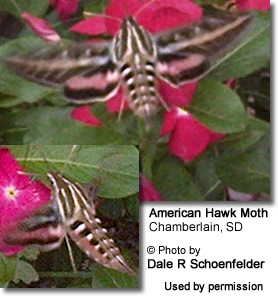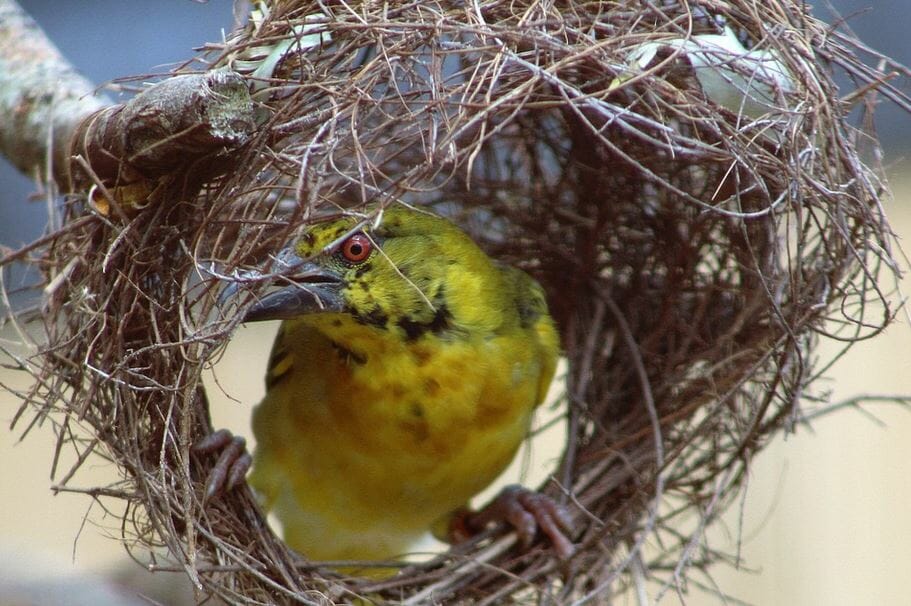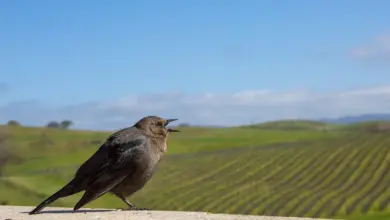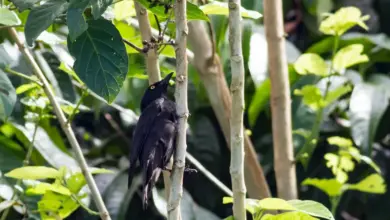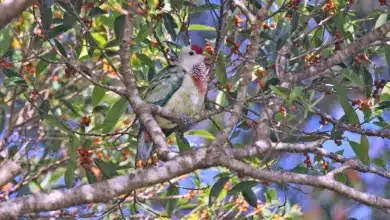Hummingbirds found in North Dakota, USA
Here is the Listing and Photos of Hummingbird Species found in North Dakota, United States with links to informational pages and photos.
Hummingbirds found in the USA (by U.S. State) … Canada … Mexico … Puerto Rico … Jamaica … Honduras
Hummingbird Information … Hummingbird Species Photo Gallery
Hummingbirds are rare in North Dakota. Originally, only the Ruby-throated was recorded to occur here, but some other species are now occasionally spotted as well …
Most reports of these birds stem from the Turtle Mountains, Pembina Hills, forested areas around Devils Lake, the valleys along the Sheyenne and Red Rivers, and to a lesser extent along the Missouri River.
Please let us know if you know of other good locations to spot hummingbirds in North Dakota!
They are most common during the late summer migration in August and during spring migration.
These tiny birds appear to be expanding their territories due to the availability of garden feeders allowing them to find food at those times when natural resources are limited due to climatic conditions. If you happen to see other hummingbirds, please e-mail us!
Ruby-throated Hummingbird (Archilochus colubris) – The most commonly seen hummingbird in North Dakota. More common in the eastern half of the state. Usually arrive between April through June. They leave by mid- or late August through October. Migrating males are usually the first to arrive and the first to depart. The females and the young usually follow about two weeks later.
The male has a ruby-red throat, a white collar, an emerald green back and a forked tail.
The female has a green back and tail feathers that are banded white, black and grey-green.
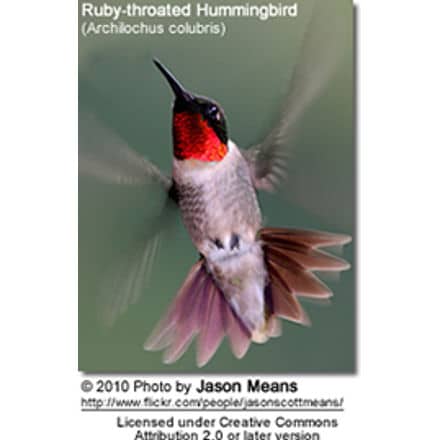
Rufous Hummingbirds (Selasphorus rufus) – Also very common – although not as numerous as the Ruby-throated. Documented in September.
These hummingbirds are usually found in gardens and at feeders. These birds are fearless, and are known for chasing away other hummingbirds and even larger birds, or rodents away from their favorite nectar feeders and flowers.
Males can easily be identified by their glossy orange-red throats.
Females have whitish, speckled throats, green backs and crowns, and rufous, white-tipped tail feathers.

Rufous Hummingbird versus the similar Ruby-throated Hummingbird (Identification)
Broad-tailed Hummingbirds (Selasphorus platycercus) – Rare
Males can most easily be identified by their iridescent, rose-red throats, white chest feathers and metallic green back and crown and their rounded tails. The males’ tails make whistling noises in flight.
Females lack the flashy throat patch of the male and are mostly pale below. Their white-tipped outer tail feathers are rust-colored close to the body and blackish in the center; the tail feathers in the center range from green to blackish.
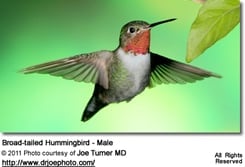
Calliope Hummingbirds (Stellula calliope formerly Archilochus calliope) – Occasional breeder
The smallest breeding bird in North America. They are most easily confused with the Rufous Hummingbirds and the Broad-tailed Hummingbird.
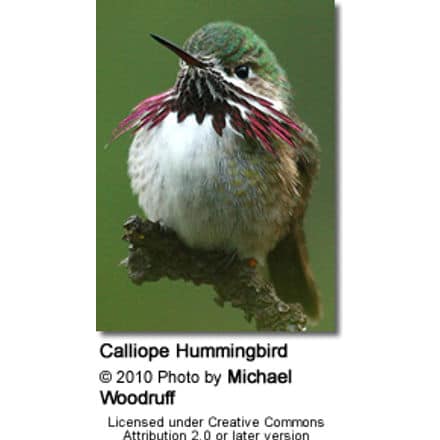
Please note: The Hawk Moth is easily confused with a hummingbird, as they have similar feeding and swift flight patterns. These moths also hover in midair while they feed on nectar.
Moths have a couple of sensors or “antennas” on top of the head, which are key identifiers.
If you see a bird that doesn’t appear to be any of the above, please e-mail comments / images to: [email protected]. Thanks!
Their favorite feeding plants are:
Shrubs / Trees / Vines
- Cardinal climber
- Scarlet trumpet vine
- Northern catalpa
- Morning glory
- Brown’s honeysuckle
- Fly honeysuckle
- Cape honeysuckle
- Coral honeysuckle
- Cypress vine
- Morning glory
- Scarlet runner bean
- Trumpet creeper
- Beauty Bush
- Old–fashioned weigela (Bristol Red, Red Prince)
- Flame acanthus
- Flowering quince
- Lantana
- Manzanita
- Mimosa
- Red buckeye
- Tree tobacco
- Turk’s cap
- Weigelia
- New Jersey tea
- Cockspur hawthorn
- Washington hawthorn
- Apples and crabapples
- Rhododendrons
- Azaleas
- Shadbush
- Flowering cherry trees
- Virginbower
- Tuliptree
- Flowering quince
- Horse chestnut
- Hybrid clematis
- Butterfly bush
- Rose of Sharon
- Lilacs
Annuals
- Nasturtium: Prefers full sun, but will also grow in partial shade
- Salvia: Anise Sage (Salvia guaranitica) – blue flowers. One of hummingbird favorites. Also: Salvia pensetmonoides and Texas Sage (Salvia coccinea), Salvia ‘Maraschino’ (Bush Salvia)
- Shrimp plant
- Geranium
- Pincushion flower
- Beard tongue
- Fire spike
- Fuchsia
- Impatiens
- Jacobiana
- Jewelweed
- Petunia
- French marigold
- Mexican sunflower
- Flame flower
- Common portulaca
- Zinnia
Biennials / Perennials
- Cardinal Flowers (Lobelia cardinalis)…beautiful native perennial. Great in beds, bogs and containers
- Purple coneflowers (for insects)
- Penstemon (penstemon digitalis)
- Royal catchfly (silene regia)
- Japanese bleeding heart
- Bee balm, Oswego tea
- Blue Fortune agastache (hardy from Zones 4-10)
- Dahlia
- Bee balm (Monarda)
- Canna
- Coral bells
- Four o’clock
- Hosta
- Hummingbird mint – (Agastache cana and Agastache rupestris / Agastache ‘Acupulco Salmon and Pink’ ) – Perennial; grows quickly; very fragrant.
- Little cigar
- Lupine
- Penstemon barbatus
- Yucca
- Impatiens
- Sweet William
- Canna Lily
- Butterflyweed
- Bluebells
- Fuschia
- Four O’clock
- Showy evening primrose
- Virginia creeper
- Cup plant
- Bugleweed
- Globe thistle
- Maltese cross
- Hollyhock
- Wild or Canada columbine; European columbine
- Delphinium
- Foxglove
- Fireweed
- Dwarf blue gentian
- Gladiolus (red colors)
- Daylily
- Coral bells
- Hosta
- Blazing Star
- Turk’s cap lily
- Wood lily
- Wild bergamot
- Moss Pink
- Wild Blue Phlox
- Phlox

